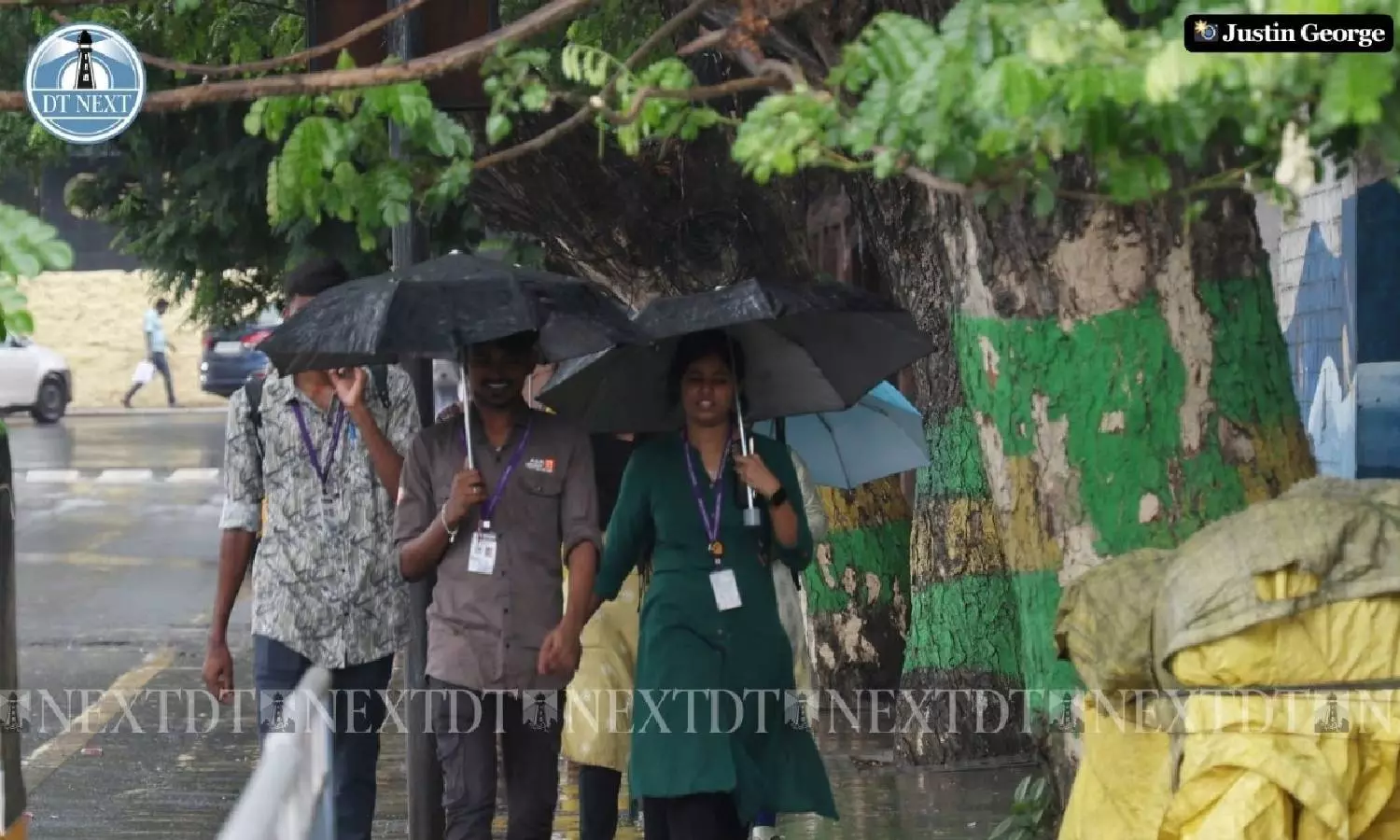


As cyclonic storm 'Fengal' approaches Tamil Nadu and Puducherry, heavy rain and strong winds have disrupted normal life in the region. Flight operations, public transport, and schools and colleges have been affected, with the IMD issuing a red alert for heavy rain. As a precautionary measure, the Tamil Nadu government has closed schools and asked IT firms to allow work from home for their employees. Cyclone Fengal is expected to make landfall near Puducherry around midday.
Cyclone Fengal: Threatens Tamil Nadu and Puducherry with Heavy Rain and Winds
Cyclone Fengal, a severe cyclonic storm, is approaching Tamil Nadu and Puducherry, bringing with it heavy rains, strong winds, and potential flooding. The Indian Meteorological Department (IMD) has issued a red alert for the region, warning of extremely heavy rainfall and rough seas.
Background
Cyclones are rotating, low-pressure storm systems that form over warm ocean waters. They are characterized by strong winds and heavy rainfall. Cyclones are common in the Bay of Bengal during the summer months, with the peak season occurring from April to December.
Impact of Cyclone Fengal
As Cyclone Fengal approaches land, it is expected to bring heavy rain and strong winds to Tamil Nadu and Puducherry. The IMD has predicted that rainfall could reach up to 20 centimeters (8 inches) in some areas. The storm is also expected to cause storm surges, flooding low-lying areas near the coast.
Precautionary Measures
Authorities in Tamil Nadu and Puducherry have taken precautionary measures to minimize the impact of Cyclone Fengal. Schools and colleges have been closed, and public transport has been suspended. The Tamil Nadu government has also advised IT firms to allow employees to work from home.
Top 5 FAQs
1. What is the expected landfall time and location of Cyclone Fengal?
Cyclone Fengal is expected to make landfall near Puducherry around midday.
2. What is the intensity of Cyclone Fengal?
Cyclone Fengal is a severe cyclonic storm, with wind speeds of up to 120 kilometers per hour (75 miles per hour).
3. What areas are most at risk from Cyclone Fengal?
The coastal districts of Tamil Nadu and Puducherry are most at risk from Cyclone Fengal. These areas include Chennai, Cuddalore, and Karaikal.
4. What precautions should people in affected areas take?
People in affected areas should stay indoors and away from windows. They should also secure loose objects and be prepared for flooding.
5. Has Cyclone Fengal caused any damage or casualties?
As of the latest reports, there have been no reports of damage or casualties caused by Cyclone Fengal. However, the storm is still approaching land, and the full extent of its impact may not be known until after it makes landfall.
Conclusion
Cyclone Fengal poses a significant threat to Tamil Nadu and Puducherry. Residents in affected areas should take necessary precautions to stay safe and minimize the impact of the storm. The IMD will continue to monitor the storm's progress and provide updates as needed.

In this edition of Health360, a renewed debate over the alleged link between vaccines and autism is sparked by tech mogul Sridhar Vembu's endorsement of a questionable study. Despite reassurances from the medical community backed by data from the WHO, doubts continue to persist, leading to potential harm to public health. The program also delves into the alarming rise in back pain cases in India and explores new treatments.

In an effort to fight the ongoing air pollution crisis, Delhi conducted its first-ever official cloud seeding operation led by IIT Kanpur. The operation involved a small aircraft dispersing specially designed chemical flares into the atmosphere to create rain. While experts say rainfall could occur within 15 minutes to 4 hours, the actual timeframe depends on various factors such as wind direction and moisture content. If successful, the government plans to continue the operation in the coming days.

In the quest for stronger, luscious hair, we often overlook the importance of nurturing the roots. Fortunately, Ayurveda has long stressed the significance of this practice, which has now been backed by modern science. Studies have shown that herbs like Bhringraj and Amla can activate hair follicles, promoting new growth and delaying greying. Fenugreek, Neem, Hibiscus, and Ashwagandha are also found to be beneficial in strengthening and nourishing the scalp, resulting in thicker and healthier hair.

A college student shares her personal journey of becoming a vegetarian, despite facing challenges and health concerns. She then delves into an ethics class she took, where the concept of marginal cases were discussed. Following an article by philosophy professor Alastair Norcross, she concludes that even though individual action may seem insignificant, refusing to consume factory-farmed meat holds moral significance due to the potential to prevent immense suffering for animals.

On October 24, the global community commemorates World Polio Day to honor the legacy of Dr. Jonas Salk and the efforts of countless individuals and organizations in the fight against polio. This highly contagious and potentially deadly disease, once a widespread epidemic, is now largely preventable thanks to the development of a life-saving vaccine. India's successful eradication of polio serves as a testament to the importance of strong vaccination programs and collaborations in public health initiatives.

As winter arrives in India, so does the hazardous air pollution. Delhi NCR's AQI has already crossed the 400 mark, making it crucial to invest in air purifiers, especially after Diwali. Dyson, Qubo, HomePure, and Philips have launched high-quality air purifiers with advanced features to tackle different types of pollutants and create cleaner indoor air. With prices ranging from Rs 5,000 to Rs 1 lakh, these purifiers are a practical and timely purchase for a healthier living.

In a recent family vlog, Indian celebrity couple Shoaib Ibrahim and Dipika Kakar shared their "natural" hair care routine for their son, using a homemade mask made with rice flour, flax seeds, and coconut oil. However, experts warn that what works for adults may not be suitable for babies, whose sensitive skin and scalp could react to the ingredients. While the ingredients may improve hair texture, they do not necessarily promote hair growth. Instead, a healthy diet and good scalp care are more important in maintaining healthy hair.

A recent consumer study has found multiple brands of soft contact lenses in the U.S. to contain "forever chemicals" that can be harmful to both the body and the environment. The study, conducted by the nonprofit organization Environmental Health Sciences, tested 18 varieties of popular contact lenses and found all of them to contain markers for PFAS. Brands such as Acuvue, Alcon, and CooperVision were among the list of affected products. This news serves as a cautionary lesson on the potential risks of overusing contact lenses.

On the birth anniversary of Dr. APJ Abdul Kalam, the ‘Missile Man’ of India, tributes pour in on social media celebrating his life, vision and impact. A visionary scientist, inspiring leader and true patriot, Dr. Kalam's humility, compassion and constant interaction with students continue to inspire generations. His tireless efforts in defense, science and youth empowerment have strengthened India's path towards self-reliance and his legacy continues to motivate young minds to dream big and work hard for the nation.

Recent studies have found that extreme heat, particularly when combined with high humidity, can have a significant impact on mental health. A study in India showed that when wet bulb temperature exceeded 27°C, the probability of reporting severe depression increased by 0.5%, even when the temperature was slightly lower. This finding is consistent with global reviews that have linked high temperatures to mood disorders, increased hospital admissions for psychiatric conditions, and even elevated suicide risk. The Lancet has also published evidence that rising temperatures worldwide are a growing threat to emotional and cognitive health.